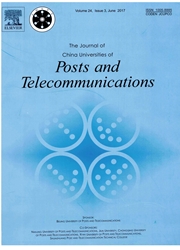

 中文摘要:
中文摘要:
精力效率是在无线传感器网络(WSN ) 的一个关键问题。为了在整个全部最小化精力消费和平衡精力驱散,联网,在 WSN 的一个系统的平衡精力的合作传播计划在这份报纸被建议。这个计划在系统的看法学习精力效率。为三主要的步,也就是聚类的节点,数据聚集和合作传播,相应措施被提出节省精力。这些措施很好被设计并且紧联合了完成最佳的性能。一个控制一半的动态聚类方法被建议避免随机选择簇头引起的簇头的集中的分发并且得到在簇节点之间的高空间的关联。基于造的簇,随动态数据压缩的采纳,数据聚集被簇头执行得到数据的更好的使用关联。有平衡精力的合作的簇的多重输出(CMIMO ) 领导的合作多重输入选择方法被建议播送数据下沉节点。这个计划的系统模型也在这份报纸被给。并且模拟结果证明与另外的传统的计划相比,建议计划能高效地在整个网络均匀地散布精力驱散并且完成更高的精力效率,它导致更长的网络一生跨度。由采用直角的空间时间块代码(STBC ) ,与簇头的百分比变化的合作传播节点的最佳的数字也被结束,它能帮助由选择合作节点的最佳的数字并且做 CMIMO 的大多数使用改进精力效率。
 英文摘要:
英文摘要:
Energy efficiency is a critical issue in wireless sensor networks (WSNs). In order to minimize energy consumption and balance energy dissipation throughout the whole network, a systematic energy-balanced cooperative transmission scheme in WSNs is proposed in this paper. This scheme studies energy efficiency in systematic view. For three main steps, namely nodes clustering, data aggregation and cooperative transmission, corresponding measures are put forward to save energy. These measures are well designed and tightly coupled to achieve optimal performance. A half-controlled dynamic clustering method is proposed to avoid concentrated distribution of cluster heads caused by selecting cluster heads randomly and to get high spatial correlation between cluster nodes. Based on clusters built, data aggregation, with the adoption of dynamic data compression, is performed by cluster heads to get better use of data correlation. Cooperative multiple input multiple output (CMIMO) with an energy-balanced cooperative cluster heads selection method is proposed to transmit data to sink node. System model of this scheme is also given in this paper. And simulation results show that, compared with other traditional schemes, the proposed scheme can efficiently distribute the energy dissipation evenly throughout the network and achieve higher energy efficiency, which leads to longer network lifetime span. By adopting orthogonal space time block code (STBC), the optimal number of the cooperative transmission nodes varying with the percentage of cluster heads is also concluded, which can help to improve energy efficiency by choosing the optimal number of cooperative nodes and making the most use of CMIMO.
 同期刊论文项目
同期刊论文项目
 同项目期刊论文
同项目期刊论文
 Bandwidth Allocation and Admission Control Scheme Based on Nash Bargaining Slolution for WiMAX Syste
Bandwidth Allocation and Admission Control Scheme Based on Nash Bargaining Slolution for WiMAX Syste Handover Improvement Based on Cost Function and User fairness for Cellular Relay Enhanced LTE Networ
Handover Improvement Based on Cost Function and User fairness for Cellular Relay Enhanced LTE Networ Distributed Multisource Transmission in Wireless Mobile Peer-to-Peer Networks: A Restless Bandit App
Distributed Multisource Transmission in Wireless Mobile Peer-to-Peer Networks: A Restless Bandit App Resource Allocation for Load Balancing and Fairness Improvement in Relay-Assisted OFDMA Cellular Net
Resource Allocation for Load Balancing and Fairness Improvement in Relay-Assisted OFDMA Cellular Net Optimal energy-efficient power control for cognitive radio based on static and dynamic features of p
Optimal energy-efficient power control for cognitive radio based on static and dynamic features of p Performance evaluations of an IDMP-based macro-mobility management in heterogeneous wireless network
Performance evaluations of an IDMP-based macro-mobility management in heterogeneous wireless network Q-Learning based Heterogeneous Network Self-Optimization for Reconfigurable Network with CPC Assista
Q-Learning based Heterogeneous Network Self-Optimization for Reconfigurable Network with CPC Assista A Novel Vertical Handoff Algorithm Based on Fuzzy Logic in Aid of Grey Prediction Theory in Wireless
A Novel Vertical Handoff Algorithm Based on Fuzzy Logic in Aid of Grey Prediction Theory in Wireless Practical Robust Uplink Pilot Time Interval Optimization Scheme for time-division multiple-input- si
Practical Robust Uplink Pilot Time Interval Optimization Scheme for time-division multiple-input- si Q-learning for Dynamic Channel Assignment in Cognitive Wireless Local Area Network with Fibre-connec
Q-learning for Dynamic Channel Assignment in Cognitive Wireless Local Area Network with Fibre-connec Outage capacity of cognitive radio in Rayleigh fading environments with imperfect channel informatio
Outage capacity of cognitive radio in Rayleigh fading environments with imperfect channel informatio Joint cooperative relay scheme for spectrum-efficient usage and capacity improvement in cognitive ra
Joint cooperative relay scheme for spectrum-efficient usage and capacity improvement in cognitive ra Optimal resource allocation scheme for cognitive radio networks with relay selection based on game t
Optimal resource allocation scheme for cognitive radio networks with relay selection based on game t Multichannel cooperative sensing for cognitive radio with users owning heterogeneous sensing ability
Multichannel cooperative sensing for cognitive radio with users owning heterogeneous sensing ability Secondary user access based on stochastic link estimation in cognitive radio with fibre-connected di
Secondary user access based on stochastic link estimation in cognitive radio with fibre-connected di Energy-efficient joint relay node selection and power allocation over multihop relaying cellular net
Energy-efficient joint relay node selection and power allocation over multihop relaying cellular net Optimal distributed power allocation for a new spectrum sharing paradigm in cognitive radio networks
Optimal distributed power allocation for a new spectrum sharing paradigm in cognitive radio networks Distributed power allocation scheme for multi-relay shared-bandwidth (MRSB) wireless cooperative com
Distributed power allocation scheme for multi-relay shared-bandwidth (MRSB) wireless cooperative com Multiplicative multi-attribute auction based optimal network selection for heterogeneous wireless ne
Multiplicative multi-attribute auction based optimal network selection for heterogeneous wireless ne Distributed optimal relay selection for spectral efficiency improvement in underlay-paradigm based C
Distributed optimal relay selection for spectral efficiency improvement in underlay-paradigm based C Pricing and power control for energy-efficient radio resource management in cognitive femtocell netw
Pricing and power control for energy-efficient radio resource management in cognitive femtocell netw Opportunistic best-relay node selection for cooperative transmission improvement over underlay cogni
Opportunistic best-relay node selection for cooperative transmission improvement over underlay cogni Distributed Best-Relay Selection for Improving TCP Performance Over Cognitive Radio Networks: A Cros
Distributed Best-Relay Selection for Improving TCP Performance Over Cognitive Radio Networks: A Cros Joint power allocation and beamforming with users selection for cognitive radio networks via discret
Joint power allocation and beamforming with users selection for cognitive radio networks via discret Dynamic Resource Allocation for Heterogeneous Services in Cognitive Radio Networks With Imperfect Ch
Dynamic Resource Allocation for Heterogeneous Services in Cognitive Radio Networks With Imperfect Ch Optimal distributed power allocation for a new spectrum sharing paradigm in cognitive radio networks
Optimal distributed power allocation for a new spectrum sharing paradigm in cognitive radio networks 期刊信息
期刊信息
